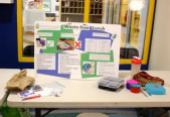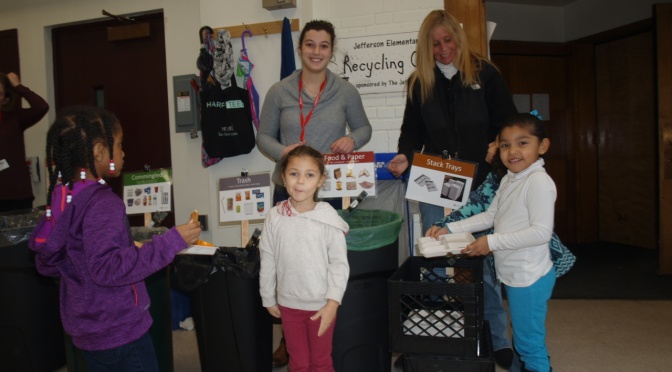We all know a regular hectic morning, between getting ourselves ready for work, getting sluggish children out of bed, showering them is optional, a cursory brush of the hair, feeding them, throwing together their lunch and snack with a quick grab into the pantry to put pre-packaged convenience food into their lunchbox, and ,still out of breath, we run them to the bus stop. Phew.
We don’t have time to think what price tag might be attached to that pre-packaged food at the other end. We are just happy to have made it again, another day of hectic working parents.
We -at We Future Cycle- working in the classrooms and in the lunchroom teaching the children about the waste and where “away” is, see it every day. We see the plastic baggies, the pre packaged meat, cracker and sauce packages, the juice boxes, the juice pouches, the single serve apple sauce pouches. We see the huge amounts of packaging materials that come in, all in the name of convenience.
As most of us don’t think past the curb where we bring our garbage can twice per week, there is no understanding what happens to the stuff once it leaves our house. It just conveniently “goes away”. Students in schools that are running the We Future Cycle Recycling program are learning that there is no “away”. Older students also learn about the cost of “away”.
Schools are spending a large portion of their budget on waste management. Every dollar spent on Waste Management is a dollar NOT spent in the classroom.
Parental convenience comes with a price tag to society.
There is a much better way, that will save money on both ends and only requires a little bit of planning. Packaging a lunch from fresh ingredients in a reusable box, and sending watered down juice in a reusable bottle will solve two big problems in schools. It will reduce the waste management costs and it will feed the children healthier to allow for better learning. I am sure you will agree with me……our children are worth the little effort.






 New Rochelle ‘s Daniel Webster Elementary School under the leadership of Melissa Passarelli and Greg Middleton has just moved back into their building.
New Rochelle ‘s Daniel Webster Elementary School under the leadership of Melissa Passarelli and Greg Middleton has just moved back into their building. Learning to identify materials and realizing that one just needs to put them in the right bin for them to be recycled was easily understood. Webster students all pledged to make a difference and they put that pledge to the test at the newly rolled out lunchroom recycling station. Three 5th grade students helped us to do a waste audit afterwards, and we had a wonderful helper at the station teaching her fellow students, especially the little ones. Thank you, Webster Students.
Learning to identify materials and realizing that one just needs to put them in the right bin for them to be recycled was easily understood. Webster students all pledged to make a difference and they put that pledge to the test at the newly rolled out lunchroom recycling station. Three 5th grade students helped us to do a waste audit afterwards, and we had a wonderful helper at the station teaching her fellow students, especially the little ones. Thank you, Webster Students.
 New Rochelle Columbus Elementary School celebrated its Red Carpet Affair on Thursday evening. Students walked on a red carpet, donned in their finest to the auditorium to see themselves on the big screen.
New Rochelle Columbus Elementary School celebrated its Red Carpet Affair on Thursday evening. Students walked on a red carpet, donned in their finest to the auditorium to see themselves on the big screen.

 Just like at the Oscar’s the “actors” were interviewed to share their thoughts. Proud students were either the interviewer or the interviewee, asking questions about what the students have learned from the on-going recycling program in their lunchroom, how their parents made differences in their households, now that the students learned about recycling. The answers were heartfelt and sincere. Clearly, Columbus students know that their actions count and each and every one can make a difference.
Just like at the Oscar’s the “actors” were interviewed to share their thoughts. Proud students were either the interviewer or the interviewee, asking questions about what the students have learned from the on-going recycling program in their lunchroom, how their parents made differences in their households, now that the students learned about recycling. The answers were heartfelt and sincere. Clearly, Columbus students know that their actions count and each and every one can make a difference.









